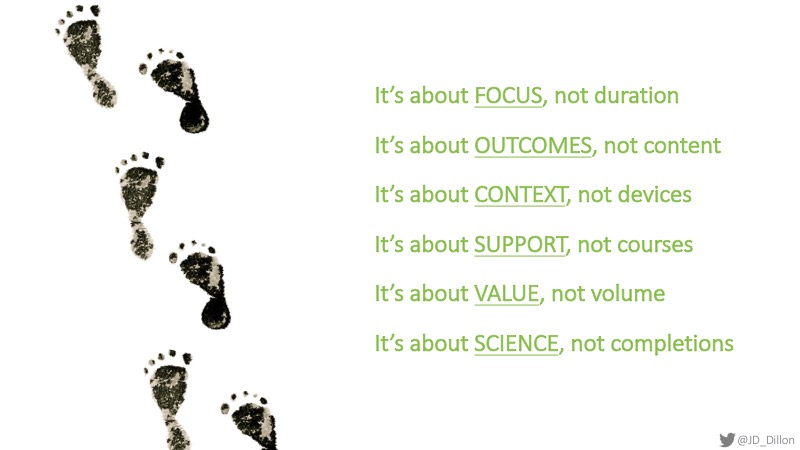Last week, I delivered a session on microlearning as part of the eLearning Guild’s DevLearn Conference in Las Vegas. You can check out the full presentation at the bottom of this post. The overall thesis is that “microlearning” isn’t a real thing. Rather, L&D should always be looking for ways to better fit what we do to help people into their reality. Read this post for more on my definition of microlearning.
I typically conclude my presentations with a few “walk away” statements or tips as a call to action. In this case, I used the slide below.
After the session was over, I shared a screenshot of the slide via Twitter …
Then I noticed the image popping up all over social media. Even without any real context, this summation seems to have landed with people who are trying to wrap their minds around the microlearning trend.
Rather than let a picture with footprints and 6 vague lines of text speak for itself, I figured it may be helpful to add a bit more detail here. So, to summarize microlearning (again) …
It’s about FOCUS, not duration.
People are still getting distracted by the duration of a learning object as related to microlearning. I continue to read articles saying that the optimum length is between 2 and 5 minutes. My reply to these claims is “BASED ON WHAT?!?!?” There is no magical duration for learning activities just like there is no perfect runtime for a YouTube video. It’s all about focus. Get in. Get your point across. Get out. By focusing on a specific, relevant, timely topic, you can add value to the user’s experience and increase the potential impact. Sure, focused experiences tend to be shorter than vague, all-over-the-place, be-sure-to-cover-everything-because-the-SME-said-so courses. But it’s the focus that adds value – not the duration.
It’s about OUTCOMES, not content.
L&D shouldn’t build stuff to say they built stuff. Unfortunately, we do that all the time to subsequently prove our value by catalogue size and offering availability. Instead, we should build content that is explicitly designed to impact a measurable business outcome. Yes, there are times when we can’t quite make this connection. But those should be exceptions, not the rule. The sad truth is that organizations have wasted a TON of time, effort and money on content they simply don’t need. Adopting the foundational principles of microlearning makes this even more clear.
It’s about CONTEXT, not devices.
Mobile is not a device. It’s a context. Support must go to the user, not expect the user to step away from the job they are paid to do in order to get help. Microlearning is not a distinctly “mobile” strategy. Rather, it’s about fitting support tools – job aids, videos, courses, etc. – into the context of the end user’s daily work. Sure, mobile devices can be super helpful with this, especially for dispersed audiences and deskless workers. However, before we build content and implement tech, we must have a deep understand of the audience’s context and evolve our strategy as their reality shifts over time.
It’s about SUPPORT, not courses.
Everything I’ve said so far can only work if we break out of the course mentality. Yes, courses are still a perfectly viable option to help people get better at their jobs. They just shouldn’t be the default tool. We must establish consistent and scalable channels for deploying right-fit support through a variety of available tactics. This is how I’ve applied a modern learning ecosystem framework to build “microlearning” over the years.
It’s about VALUE, not volume.
No one cares about how much stuff L&D makes – except L&D. An employee just wants to solve THIS problem right NOW. The more value-add moments we have, the more currency we put in the bank when we need support for bigger initiatives in the future. The role of L&D is being called into question because we struggle to consistently back our wisdom and experience with tangible business value. Rather than measure our value based on meaningless stats like the average number of training hours delivered per employee per year, we must deliver hard data based on established business priorities (sales, fines, injuries, loss, turnover, engagement, etc.).
It’s about SCIENCE, not completions.
I don’t care if people completed the training. I care if their behavior changes sufficiently to impact business results. How we get there doesn’t really matter! This outcome requires L&D pros to view their jobs as not just an art but also a hard science and therefore apply what we know about how learning REALLY works – even if stakeholders are still asking for classes all the time. We all don’t have to become cognitive psychologists, but we need to understand fundamentals concepts like spaced repetition, retrieval practice and interleaving in order to bake them into our strategies.
Here’s my full annotated DevLearn presentation via SlideShare.
https://www.slideshare.net/JDDillon/more-than-micro-designing-learning-that-fits-devlearn-2017-81112153
What are your thoughts on microlearning? Does it have value? How do microlearning principles inform your L&D work?




